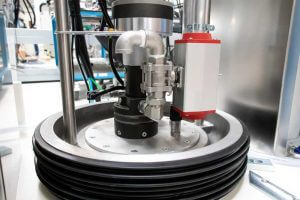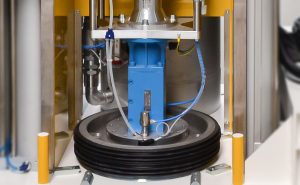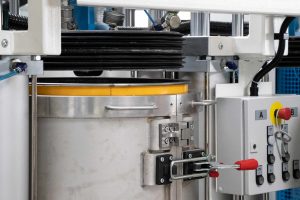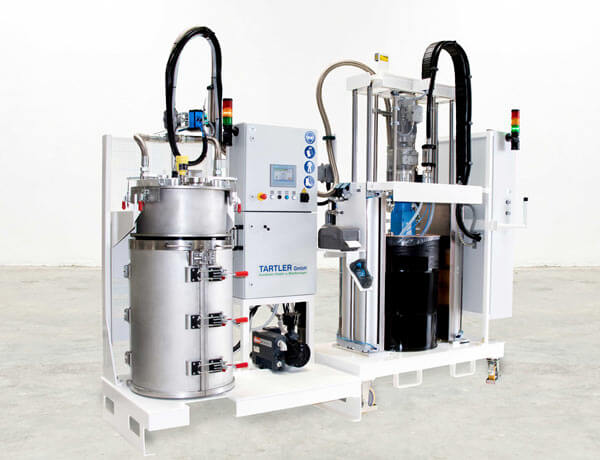TARTLER’s new vacuum system sets the standard when it comes to drum changes
Quickly and safely changing component drums ranks among the key process steps when processing high-viscosity polyurethane and epoxy resins and silicones. The possibility and risk of air getting into the system or the process during the drum change is a tricky issue. When subsequently pumping out and processing the material, this “harmful air” then causes technical disturbances, which in some cases can even endanger the safety of the machine operator. Common follower plate devices do little to change this. TARTLER’s new fully automatic vacuum deaeration system with a vacuum drum eliminates all those issues.
Currently, anyone who processes high-viscosity silicones, polyurethane or epoxy resins in highly automated dosing and mixing systems principally has three options when routinely changing the clamping ring lidded drums with A and B components: Going by tradition (not to be recommended), by the currently established method (better), or using TARTLER’s new vacuum drum change system TAVA 200 D (innovative).
 First option: Technically outdated
First option: Technically outdated
The traditionalists among plastic processors who cling onto the traditional method of drum changes and still manually carry out drum deaeration before or during transfer via a ball valve or other openings should know: It is no longer up to date, offers no process safety whatsoever and – since there is a risk of dangerous splashes – can end badly. For decades, this method was part of daily operations in dosing and mixing technology. Withdrawing a few cups full of material with a ball valve until no air is thought to be left under the follower plate, and start. If there was still any air under the follower plate, the supply und dosing pumps “choked” on it and the process may have had to have been interrupted. Additionally, when driving out the follower plate, splashes were possible because the required compressed air in the drum could “discharge” at this moment. High cleaning effort, constant material loss and residual quantities in the drum, and a possible contamination of the employee were the consequences – leaving the safety officer to throw their hands up in the air. As we said, today this is outdated.
 Second option: The current standard
Second option: The current standard
Much more advanced, and significantly safer is the currently widespread method, by which deaeration is carried out under the application of vacuum. Any existing air between the follower plate and the surface of the material in the drum is drawn off until the follower plate sits tightly on the material. This approach during a drum change is relatively user friendly, prevents dangerous splashes and minimises material loss. However, the method only captures the “harmful air” above the material and no high vacuum can be generated. Under the aspects of process safety and material efficiency, this approach is also suboptimal. Moreover, it is not suitable for all materials. It is, however, the currently established method.
Third option: Pioneering
 TARTLER’s new system solution TAVA 200 D eliminates all process and safety issues during the routine change of material drums with high-viscosity polyurethane or epoxy resins. It is a fully automated vacuum system with a vacuum drum to take up, pump out and ventilate the industry-standard lidded drums. The TAVA 200 D guarantees that no air is introduced into the mixing and dosing system during the drum change. This is because a vacuum of -0.97 bar is generated between the material surface and the follower plate. The air in the drum is fully and continuously extracted via vacuum connection through a drum follower plate that is pervious to air but not to media. It also captures any air that may have gotten into the supply and dosing pumps (because pasty material may have dripped out when lifting the previous drum follower plate). Any splashes due to overpressure is generally ruled out, since with the TAVA 200 D, the follower plate is driven out under pressure and minimal vacuum is applied shortly before its discharge out of the drum.
TARTLER’s new system solution TAVA 200 D eliminates all process and safety issues during the routine change of material drums with high-viscosity polyurethane or epoxy resins. It is a fully automated vacuum system with a vacuum drum to take up, pump out and ventilate the industry-standard lidded drums. The TAVA 200 D guarantees that no air is introduced into the mixing and dosing system during the drum change. This is because a vacuum of -0.97 bar is generated between the material surface and the follower plate. The air in the drum is fully and continuously extracted via vacuum connection through a drum follower plate that is pervious to air but not to media. It also captures any air that may have gotten into the supply and dosing pumps (because pasty material may have dripped out when lifting the previous drum follower plate). Any splashes due to overpressure is generally ruled out, since with the TAVA 200 D, the follower plate is driven out under pressure and minimal vacuum is applied shortly before its discharge out of the drum.
The TAVA 200 D from TARTLER generates and regulates the vacuum via a control unit with a process-oriented design. The application of vacuum is only switched off when there is absolutely no air left in the system. Everything is designed for maximum process optimisation and safety. The system is user friendly, operates fully automatically and offers the user full control with no material loss, no risk of splashing and no manual effort. In cooperation with TARTLER’s intelligent machine control of the mixing and dosing system from the NODOPOX and TARDOSIL series, the TAVA 200 D sets a new standard in the processing of pasty polyurethane and epoxy resins and silicones. And there are already signs that this innovation from Michelstadt is also set to revolutionise the drum change processes in other areas of fluid technology.



 First option: Technically outdated
First option: Technically outdated Second option: The current standard
Second option: The current standard TARTLER’s new system solution TAVA 200 D eliminates all process and safety issues during the routine change of material drums with high-viscosity polyurethane or epoxy resins. It is a fully automated vacuum system with a vacuum drum to take up, pump out and ventilate the industry-standard lidded drums. The TAVA 200 D guarantees that no air is introduced into the mixing and dosing system during the drum change. This is because a vacuum of -0.97 bar is generated between the material surface and the follower plate. The air in the drum is fully and continuously extracted via vacuum connection through a drum follower plate that is pervious to air but not to media. It also captures any air that may have gotten into the supply and dosing pumps (because pasty material may have dripped out when lifting the previous drum follower plate). Any splashes due to overpressure is generally ruled out, since with the TAVA 200 D, the follower plate is driven out under pressure and minimal vacuum is applied shortly before its discharge out of the drum.
TARTLER’s new system solution TAVA 200 D eliminates all process and safety issues during the routine change of material drums with high-viscosity polyurethane or epoxy resins. It is a fully automated vacuum system with a vacuum drum to take up, pump out and ventilate the industry-standard lidded drums. The TAVA 200 D guarantees that no air is introduced into the mixing and dosing system during the drum change. This is because a vacuum of -0.97 bar is generated between the material surface and the follower plate. The air in the drum is fully and continuously extracted via vacuum connection through a drum follower plate that is pervious to air but not to media. It also captures any air that may have gotten into the supply and dosing pumps (because pasty material may have dripped out when lifting the previous drum follower plate). Any splashes due to overpressure is generally ruled out, since with the TAVA 200 D, the follower plate is driven out under pressure and minimal vacuum is applied shortly before its discharge out of the drum.

